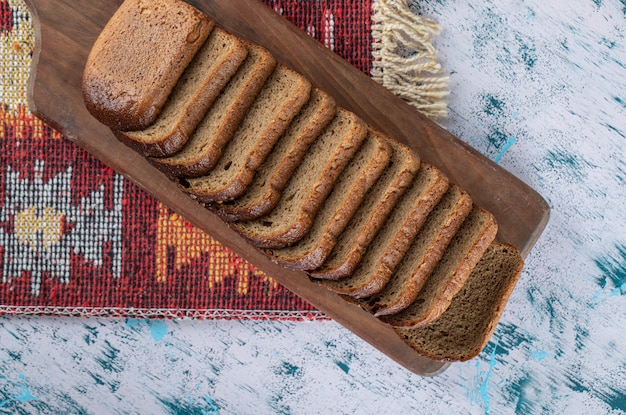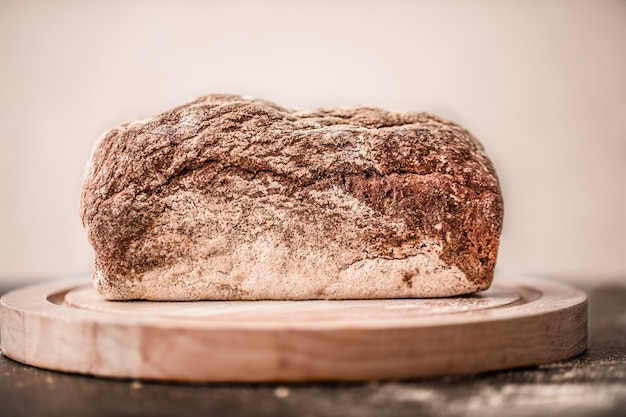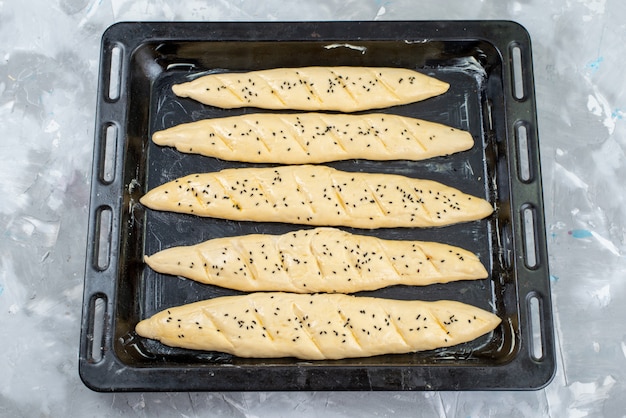Ah, meatloaf. A culinary comfort classic that evokes warm memories of childhood dinners and family gatherings. But let's be honest, even seasoned cooks can find themselves wrestling with the question: how long does it take to cook a 2 lb meatloaf? It's a question that demands a precise answer, especially if you want to avoid a dry, overcooked mess.
Fear not, my fellow meatloaf enthusiasts! I'm here to guide you through the intricacies of meatloaf cooking, sharing my personal insights and tricks gleaned from years of culinary adventures. We'll explore the factors that influence cooking time, the importance of a trusty meat thermometer, and even delve into some delicious variations on the classic recipe. So, grab your apron, fire up the oven, and let's embark on this meatloaf journey together.
(Part 1) The Basics: A Framework for Success

A 2 lb meatloaf is a perfect size for a family meal or a gathering of friends. It's a hearty centerpiece that promises leftovers for lunches and sandwiches, making it a kitchen hero. But before we dive into the specifics of cooking time, let's lay down a foundation:
The meatloaf recipe: My Go-To Formula
Every good meatloaf starts with a good recipe, and mine has been a family favorite for generations. It's a simple, adaptable formula that allows for personal touches and creative experimentation:
- ground beef: 1.5 lb. I prefer a blend of 80/20 and 90/10 for a rich, juicy result. The fat content is key!
- Breadcrumbs: 1/2 cup. These act as a binder and add texture.
- Milk: 1/2 cup. Adds moisture and keeps the meatloaf tender.
- Egg: 1, beaten. Helps bind the ingredients and adds structure.
- Onion: 1 medium, chopped. Adds sweetness and depth of flavor.
- Green Bell Pepper: 1/2 cup, chopped. Provides a subtle, fresh flavor.
- Seasonings:
- Salt: 1 teaspoon
- Black Pepper: 1/2 teaspoon
- Garlic Powder: 1/2 teaspoon
- Ketchup Glaze: 1/4 cup for that signature tangy sweetness.
This is just a starting point. Don't be afraid to get creative! Experiment with chopped mushrooms, bacon, herbs, chili powder, or any other ingredients that tickle your fancy.
(Part 2) Oven Temperature: The Foundation of Even Cooking

The temperature of your oven is a crucial factor in achieving a perfectly cooked meatloaf. The ideal temperature is 350°F (175°C). This ensures even cooking throughout the loaf, preventing the outside from burning before the inside is done.
If you crank up the heat, you risk creating a crispy, overcooked exterior while the center remains undercooked. On the other hand, baking at a lower temperature will prolong the cooking time, which might not be ideal if you're on a tight dinner schedule.
(Part 3) The Meat Thermometer: Your Culinary Guardian Angel

Here's the truth: a meat thermometer is your best friend when cooking meatloaf. It takes the guesswork out of the process, ensuring that your loaf is cooked through to a safe internal temperature. Aim for 160°F (71°C) in the thickest part of the loaf.
I know what you're thinking: a meat thermometer might seem like overkill for something as simple as meatloaf. But trust me, it's worth the investment. It's a cheap insurance policy against undercooked meat and potential foodborne illness.
Using a Meat Thermometer: A Quick Guide
Inserting the meat thermometer into the loaf is a simple task. Just place the probe into the thickest part, making sure it doesn't touch any bones. Wait a few seconds for the temperature to stabilize, and then you'll know if your meatloaf is ready.
(Part 4) The Art of Resting: Unlocking Tenderness and Flavor
Once the meatloaf reaches the desired internal temperature, don't rush to serve it. Give it a 10-15 minute rest. This seemingly insignificant step makes a world of difference in the final result.
During this rest time, the juices trapped within the meatloaf redistribute, creating a more tender, flavorful, and juicy loaf. Cover the loaf loosely with foil while it rests to keep it warm and prevent drying out.
Remember to factor this rest time into your overall cooking plan. If you want to serve dinner at 7:00 PM, aim to have the meatloaf out of the oven around 6:45 PM. This ensures a timely and delicious meal!
(Part 5) Tips and Tricks: Elevating Your Meatloaf Game
Over the years, I've picked up a few tips and tricks that have become staples in my meatloaf arsenal. These little tweaks can make a big difference in the final product, transforming a good meatloaf into a culinary triumph:
- Shape Matters: I always strive for a slightly oval-shaped loaf. This helps the juices circulate evenly, resulting in a more succulent texture. And it looks more appealing on the platter, doesn't it?
- Gentle Mixing: Don't overwork the meat! Mix the ingredients together gently to avoid making the meatloaf tough and dry.
- The Ketchup Glaze: That classic ketchup glaze adds a wonderful sweetness and tang to the meatloaf. Get creative and add a pinch of brown sugar, a dash of Worcestershire sauce, or a touch of mustard for an extra layer of flavor.
- Bake in a Loaf Pan: A loaf pan helps the meatloaf hold its shape and ensures even cooking. If you don't have a loaf pan, you can use a baking dish. Line it with parchment paper for easy cleanup.
(Part 6) Serving Suggestions: The perfect meatloaf Accompaniments
What's a meatloaf feast without the perfect accompaniments? Here are some of my favorite pairings that complement the richness and savory flavors of this iconic dish:
- mashed potatoes: A classic combination for a reason. Creamy, buttery mashed potatoes are a comforting foil to the meatloaf's heartiness.
- green beans: A simple side that provides a refreshing contrast to the richness of the meatloaf. Steam them, roast them, or sauté them with garlic and butter.
- Gravy: A homemade gravy adds a touch of richness and depth of flavor to the meal. You can create a simple pan gravy from the drippings in the pan or use a store-bought mix if time is short.
These suggestions are just a starting point. Don't be afraid to experiment with different side dishes that appeal to your taste buds.
(Part 7) The Art of Leftovers: Transforming Leftovers into Deliciousness
Let's face it, you're probably going to have leftovers. And that's a good thing! Meatloaf is even more delicious the next day.
Slice it up and serve it cold in a sandwich, or heat it up in the oven or microwave. I particularly enjoy a meatloaf sandwich with mayonnaise, mustard, and a juicy slice of tomato. A delightful taste of comfort food!
(Part 8) Variations on a Theme: Beyond the Traditional
Meatloaf isn't limited to the classic beef recipe. Get creative and experiment with different ingredients and flavor combinations to create unique culinary experiences:
Chicken Meatloaf: A Lighter Option
For a lighter, leaner option, use ground chicken instead of beef. Add herbs like rosemary or thyme for a burst of fresh flavor. It's a delicious alternative that won't weigh you down.
Turkey Meatloaf: A Lean and Flavorful Choice
Another healthy alternative is ground turkey. It's leaner than beef but still delivers a robust flavor. For added richness, mix in a small amount of ground pork.
Vegetarian Meatloaf: A Plant-Based Delight
Don't think meatloaf is off-limits to vegetarians! Use lentils, mushrooms, and breadcrumbs to create a hearty loaf that's bursting with flavor. You can even add chopped vegetables like carrots and celery for added texture and nutrition.
(Part 9) Cooking Time Table: A Quick Reference Guide
Here's a handy table to guide you through cooking times for various meatloaf sizes. Keep in mind that these are estimates, and it's always best to use a meat thermometer to ensure your meatloaf is cooked through:
| Meatloaf Weight (lbs) | Cooking Time (mins) |
|---|---|
| 1 lb | 60-75 |
| 1.5 lb | 75-90 |
| 2 lb | 90-105 |
| 2.5 lb | 105-120 |
(Part 10) FAQs: Addressing Your Meatloaf Queries
1. Can I Cook My Meatloaf in a slow cooker?
Absolutely! Use a slow cooker liner to prevent sticking. The cooking time will be longer, but it's a hands-off method that's ideal for busy schedules. About 4-6 hours on low should do the trick.
2. What if My Meatloaf is Still Pink in the Middle?
Don't fret! It's likely just the fat in the meatloaf. Give it a little more time in the oven and check the internal temperature again with your meat thermometer. It should reach 160°F (71°C) eventually.
3. Can I Freeze Meatloaf?
Yes, you can freeze cooked meatloaf for up to 3 months. To freeze, let it cool completely, then wrap it tightly in plastic wrap and foil. To thaw, place it in the refrigerator overnight. Reheat in the oven or microwave.
4. How Can I Ensure My Meatloaf Isn't Dry?
The key is to use a good mix of lean and fat ground beef. I prefer a blend of 80/20 and 90/10. You can also add a bit of milk or breadcrumbs to the mixture to keep it moist. And remember, don't overcook it! Use a meat thermometer to ensure it reaches the desired temperature.
5. What Can I Do with Leftover Meatloaf?
The possibilities are endless! Make sandwiches, salads, or even meatloaf fritters. Get creative and use it in any recipe that calls for ground beef.
Now, armed with this knowledge, you're ready to tackle any meatloaf challenge. So, put on your chef's hat, embrace the delicious possibilities, and create a masterpiece. Happy meatloaf making!
Everyone is watching

Corn on the Cob: The Ultimate Guide to Perfectly Cooked Ears
Healthy MealsAh, corn on the cob. Just the name evokes images of sunny days, barbecues, and that sweet, juicy flavour that ...

Perfect Pork Roast Oven Cooking Time: A Guide to Delicious Results
Healthy MealsThere's something truly satisfying about a perfectly roasted pork. The aroma alone is enough to make your mout...

Ham Cooking Time: How Long to Bake, Smoke, or Boil a Delicious Ham
Healthy MealsAh, ham. It's a classic, isn't it? A real crowd-pleaser, especially around holidays. And when done right, it'...

Scallops: The Ultimate Guide to Perfect Cooking
Healthy MealsAh, scallops. Those delicate, sweet, and utterly delicious morsels of the sea. They hold a special place in my...

Spaghetti Squash: The Ultimate Guide to Cooking and Serving
Healthy MealsRemember that time you saw spaghetti squash at the supermarket, looking all bumpy and strange, and thought, "W...
